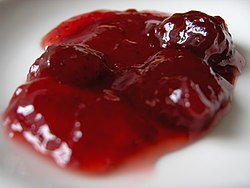Fruit preserves

Strawberry jam, one type of common fruit preserve
|
|
| Type | Spread |
|---|---|
| Main ingredients | Fruits or vegetables; sugar, honey or pectin |
| 257 kcal (1076 kJ) | |
| |
|
Fruit preserves are preparations of fruits, vegetables and sugar, often canned or sealed for long-term storage.
Many varieties of fruit preserves are made globally, including sweet fruit preserves, such as those made strawberry or apricot, and savory preserves, such as those made from tomatoes or squash. The ingredients used and how they are prepared determine the type of preserves; jams, jellies, and marmalades are all examples of different styles of fruit preserves that vary based upon the fruit used. In English, the word, in plural form, "preserves" is used to describe all types of jams and jellies.
The term 'preserves' is usually interchangeable with 'jams'. Some cookbooks define preserves as cooked and gelled whole fruit (or vegetable), which includes a significant portion of the fruit. In the English speaking world, the two terms are more strictly differentiated and, when this is not the case, the more usual generic term is 'jam'.
The singular preserve or conserve is used as a collective noun for high fruit content jam, often for marketing purposes. Additionally, the name of the type of fruit preserves will also vary depending on the regional variant of English being used.
A chutney is a pungent relish of Indian origin made of fruit, spices and herbs. Although originally intended to be eaten soon after production, modern chutneys are often made to be sold, so require preservatives – often sugar and vinegar – to ensure they have a suitable shelf life. Mango chutney, for example, is mangoes reduced with sugar.
While confit, the past participle of the French verb confire, "to preserve", is most often applied to preservation of meats, it is also used for fruits or vegetables seasoned and cooked with honey or sugar till jam-like. Savory confits, such as ones made with garlic or fennel, may call for a savory oil, such as virgin olive oil, as the preserving agent.
A conserve, or whole fruit jam, is a jam made of fruit stewed in sugar. Traditional whole fruit preserves are particularly popular in Eastern Europe (Russia, Ukraine, Belarus) where they are called varenye, the Baltic region where they're known by a native name in each of the countries (Lithuanian: uogienė, Latvian: ievārījums, Estonian: moos), as well as in many regions of Western, Central and Southern Asia, where they are referred to as murabba. In Romania they are known as dulceata.
...
Wikipedia
